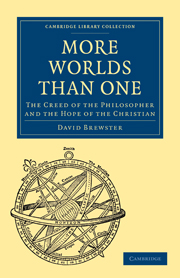Book contents
- Frontmatter
- Contents
- PREFACE
- INTRODUCTION
- CHAP. I Religious Aspect of the Question
- CHAP. II Description of the Solar System
- CHAP. III The Geological Condition of the Earth
- CHAP. IV Analogy between the Earth and the other Planets
- CHAP. V The Sun, Moon, Satellites, and Asteroids
- CHAP. VI The Motion of the Solar System round a distant Centre
- CHAP. VII Religious Difficulties
- CHAP. VIII Single Stars and Binary Systems
- CHAP. IX Clusters of Stars and Nebulæ
- CHAP. X General Summary
- CHAP. XI Reply to Objections drawn from Geology
- CHAP. XII Objections from the Nature of Nebulæ
- CHAP. XIII Objections from the Nature of the Fixed Stars and Binary Systems
- CHAP. XIV Objections from the Nature of the Planets
- CHAP. XV The Future of the Universe
CHAP. V - The Sun, Moon, Satellites, and Asteroids
Published online by Cambridge University Press: 29 August 2010
- Frontmatter
- Contents
- PREFACE
- INTRODUCTION
- CHAP. I Religious Aspect of the Question
- CHAP. II Description of the Solar System
- CHAP. III The Geological Condition of the Earth
- CHAP. IV Analogy between the Earth and the other Planets
- CHAP. V The Sun, Moon, Satellites, and Asteroids
- CHAP. VI The Motion of the Solar System round a distant Centre
- CHAP. VII Religious Difficulties
- CHAP. VIII Single Stars and Binary Systems
- CHAP. IX Clusters of Stars and Nebulæ
- CHAP. X General Summary
- CHAP. XI Reply to Objections drawn from Geology
- CHAP. XII Objections from the Nature of Nebulæ
- CHAP. XIII Objections from the Nature of the Fixed Stars and Binary Systems
- CHAP. XIV Objections from the Nature of the Planets
- CHAP. XV The Future of the Universe
Summary
So strong has been the belief that the Sun cannot be a habitable world, that a scientific gentleman was pronounced by his medical attendant to be insane, because he had sent a paper to the Royal Society, in which he maintained “that the light of the sun proceeds from a dense and universal aurora which may afford ample light to the inhabitants of the surface beneath, and yet be at such a distance aloft, as not to annoy them;”—that “vegetation may obtain there as well as with us,”—that “there may be water and dry land there, hills and dales, rain, and fair weather,”—and that “as the light and the seasons must be eternal,” the “sun may easily be conceived to be by far the most blissful habitation of the whole system.” In less than ten years after this apparently extravagant notion was considered a proof of insanity, it was maintained by Sir William Herschel as a rational and probable opinion, which might be deduced from his own observations on the structure of the sun.
It is by no means necessary that those who believe in a plurality of worlds within the limits of our own system, should adopt the opinion that the sun which lights it, and the many satellites which light the primary planets, should be inhabited worlds.
- Type
- Chapter
- Information
- More Worlds Than OneThe Creed of the Philosopher and the Hope of the Christian, pp. 88 - 109Publisher: Cambridge University PressPrint publication year: 2009First published in: 1854



